Related Research Articles

Barkudia insularis commonly known as the Madras spotted skink is a critically endangered limbless skink which was described in 1917 by Nelson Annandale and rediscovered in the wild in 2003. Little is known about the species but it is believed to be found only in the mangrove habitats near Barkud Island in Chilka Lake, Odisha, India. The lizard looks like a large earthworm and lives in the subsoil and probably feeds on small arthropods.
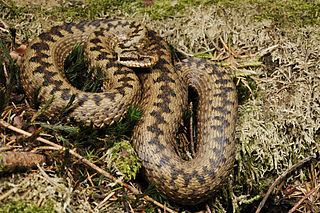
Vipera berus, the common European adder or common European viper, is a venomous snake that is extremely widespread and can be found throughout most of Western Europe and as far as East Asia.

Russell's viper is a venomous snake in the family Viperidae native to the Indian subcontinent and one of the big four snakes in India. It was described in 1797 by George Shaw and Frederick Polydore Nodder, and named after Patrick Russell, who wrote about it in his 1796 work An account of Indian serpents, collected on the coast of Coromandel.

Bitis is a genus of venomous vipers found in Africa and the southern Arabian Peninsula. It includes the largest and the smallest vipers in the world. Members are known for their characteristic threat displays that involve inflating and deflating their bodies while hissing and puffing loudly. The type species for this genus is B. arietans, which is also the most widely distributed viper in Africa. Currently, 15 species are recognized.

Atheris squamigera is a viper species endemic to west and central Africa. No subspecies are currently recognized. Like all vipers, the species is venomous.

Causus is a genus of venomous vipers found only in sub-Saharan Africa. It is a group considered to be among the most primitive members of the family Viperidae based on head scalation, oviparity, venom apparatus, and because they have round pupils. However, this is contradicted by recent molecular studies. Seven species are currently recognized. They are commonly known as night adders.

Vipera ammodytes is a viper species found in southern Europe, mainly the Balkans, and parts of the Middle East. It is reputed to be the most dangerous of the European vipers due to its large size, long fangs and high venom toxicity. The specific name, ammodytes, is derived from the Greek words ammos, meaning "sand", and dutes, meaning "burrower" or "diver", despite its preference for rocky habitats. Five subspecies are currently recognized, including the nominate subspecies described here.
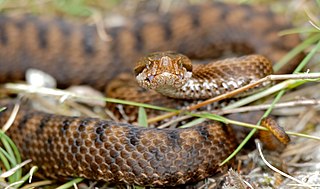
Vipera aspis is a venomous viper species found in southwestern Europe. Its common names include asp, asp viper, European asp, and aspic viper, among others. Bites from this species can be more severe than from the European adder, V. berus; not only can they be very painful, but also about 4% of all untreated bites are fatal. The specific epithet, aspis, is a Greek word that means "viper." Five subspecies are currently recognized, including the nominate subspecies described here.
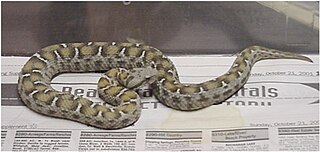
Montivipera albizona, the central Turkish mountain viper, is a venomous viper species endemic to the mountainous regions of central Turkey. No subspecies are currently recognized.
In snakes and amphibians, the canthus, canthal ridge or canthus rostralis, is the angle between the flat crown of the head and the side of the head between the eye and the snout, or more specifically, between the supraocular scale and the rostral scale. It is defined as a sharp ridge in many viperids, but is rounded in most rattlesnakes, for example.

Atheris desaixi, commonly known as the Mount Kenya bush viper, Ashe's bush viper, or Desaix's bush viper, is a venomous species of viper endemic to Kenya, where only two isolated populations are known. It is known for its striking black and yellow coloration. No subspecies are currently recognized.

Montivipera raddei albicornuta is a venomous viper subspecies endemic to Iran. It is a subspecies of Montivipera raddei.
Vipera ammodytes meridionalis is a venomous viper subspecies endemic to Greece and Turkish Thrace.
Vipera ammodytes montandoni is a venomous viper subspecies endemic to Bulgaria and southern Romania.
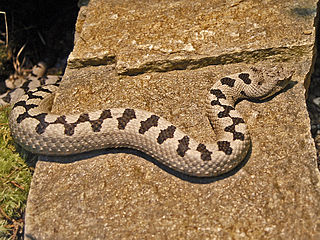
Vipera transcaucasiana is a venomous viper species endemic to parts of Georgia and northern Turkish Anatolia.

Snakes, like other reptiles, have skin covered in scales. Snakes are entirely covered with scales or scutes of various shapes and sizes, known as snakeskin as a whole. A scale protects the body of the snake, aids it in locomotion, allows moisture to be retained within, alters the surface characteristics such as roughness to aid in camouflage, and in some cases even aids in prey capture. The simple or complex colouration patterns are a property of the underlying skin, but the folded nature of scaled skin allows bright skin to be concealed between scales then revealed in order to startle predators.
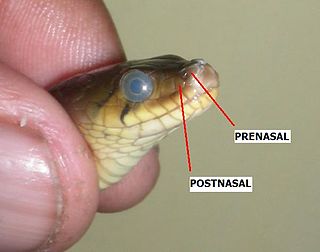
In reptiles, the nasal scale refers to the scale that encloses the nostril.
The mental scale, or mental, in snakes and other scaled reptiles refers to the median plate on the tip of the lower jaw. It is a triangular scale that corresponds to the rostral of the upper jaw. The reference to the term 'mental' comes from the mental nerve which addresses the chin and lower jaw in animals. In snakes, the shape and size of this scale is sometimes one of the characteristics used to differentiate species from one another.

In snakes, the internasal scales are those on top of the head between the scales that surround the nostrils. They are usually paired and situated just behind the rostral.

The Persian horned viper is a species of venomous vipers endemic to the Middle East and Asia.
References
- ↑ Mallow D, Ludwig D, Nilson G. 2003. True Vipers: Natural History and Toxinology of Old World Vipers. Malabar, Florida: Krieger Publishing Company. 359 pp. ISBN 0-89464-877-2.